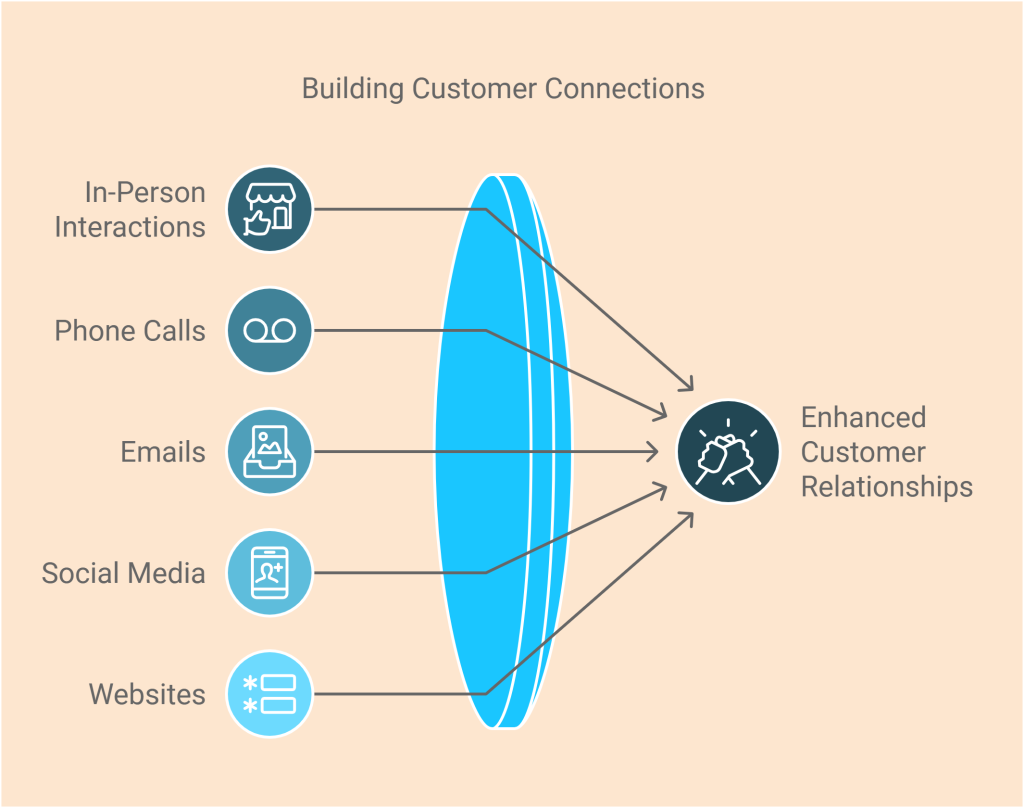How do customers engage with a business? By identifying and understanding customer touch points, businesses can get a better picture of engagement throughout the customer journey. Then they can optimize these touchpoints, deliver exceptional experiences, and build stronger relationships. In this article, we explore different types of customer touchpoints, analyze strategies, and discuss ways to optimize customer interactions.

What are customer touchpoints?
Customer touchpoints are the points of interaction between a customer and a business. These can occur across various channels, such as in-person interactions, phone calls, emails, social media, and websites. Each touchpoint presents an opportunity to engage, deliver value, and gather insights.
Here are some examples of customer touchpoints.
When customers walk into a physical store, they are immediately greeted by a friendly salesperson. This initial interaction sets the tone for the entire customer experience. The salesperson asks customers if they need any assistance and guides them through the store, showcasing the latest products and offering personalized recommendations. The customer feels valued and appreciated, which creates a positive touchpoint.
Similarly, when customers call a company’s customer service hotline, they expect to be met with a helpful and knowledgeable representative. The representative listens attentively to the customer’s concerns, provides clear solutions, and ensures that the customer feels supported throughout the conversation. This phone call becomes a significant touchpoint, as it can either leave the customer satisfied and loyal or frustrated and dissatisfied.
Emails also play a crucial role in customer touchpoints. When a customer receives a personalized email from a company, addressing them by their name and offering exclusive discounts or relevant information, it creates a sense of connection. Companies that actively engage with their customers on social media, addressing their queries and concerns in a timely manner, create positive touchpoints.
Why are customer touchpoints important?
All of these interactions not only resolve customer issues but also demonstrate a company’s commitment to customer satisfaction.
Effective identification of customer touchpoints requires a deep understanding of customer journeys. It involves mapping out the different stages customers go through and the channels they use during these stages. By doing so, businesses can identify critical touchpoints at each stage and tailor experiences accordingly.
Exploring Different Types of Customer Touchpoints

Customer touch points can vary depending on the industry, business model, and customer preferences. Let’s explore some of the most common types:
1. In-Person Interactions
Face-to-face interactions with customers, such as in a store or during a meeting, provide valuable touchpoints. They allow businesses to understand individual needs, offer personalized recommendations, and create memorable experiences.
During in-person interactions, businesses have the opportunity to engage all the senses of their customers. For example, a clothing store can create a welcoming ambiance with soft lighting, pleasant music, and a pleasant fragrance. This sensory experience enhances the touchpoint and leaves a lasting impression on the customer.
Furthermore, in-person interactions enable businesses to showcase their expertise and build trust. A knowledgeable salesperson can provide detailed information about products, answer questions, and address any concerns the customer may have. This level of personal attention helps to establish a strong customer-business relationship.
2. Phone Calls
Phone calls remain a significant touchpoint for customer service and sales. Businesses can use phone conversations to address inquiries, resolve issues, and provide guidance. Effective call handling and customer-centric approaches can enhance the overall experience.
When it comes to phone calls, businesses can take advantage of technology to improve the touchpoint. For instance, implementing an interactive voice response (IVR) system can streamline the customer’s journey by routing them to the appropriate department or providing self-service options.
This reduces wait times and frustration, resulting in a more positive interaction.
Additionally, businesses can train their customer service representatives to actively listen and empathize with customers over the phone. By showing genuine care and understanding, businesses can create a personal connection and leave customers feeling valued and satisfied.
3. Emails
Emails serve as a versatile touchpoint for communication. They can be used for various purposes, including onboarding, customer support, promotions, and updates. Crafting compelling emails with personalized content helps businesses engage customers and nurture relationships.
When it comes to email touchpoints, businesses can leverage data and analytics to tailor their messages to individual customers. By analyzing customer behavior and preferences, businesses can send targeted emails that are more likely to resonate with recipients. This personalization increases the chances of engagement and conversion.
In addition to personalized content, businesses can enhance the email touchpoint by optimizing the design and layout. Using eye-catching visuals, clear call-to-action buttons, and mobile-responsive templates ensures that emails are visually appealing and easy to navigate on different devices. This attention to detail contributes to a positive email experience for customers. Incorporating consistent branding elements, including a well-crafted logo design, can further strengthen brand recognition and trust in every email communication.
4. Social Media
Social media platforms provide an opportunity for businesses to interact with customers on a more casual and engaging level. Through comments, direct messages, and social media mentions, businesses can address concerns, share updates, and build brand loyalty.
One of the advantages of social media touchpoints is the ability to create a sense of community. Businesses can foster conversations and encourage customers to share their experiences, opinions, and feedback. By actively participating in these discussions, businesses can strengthen their relationship with customers and gain valuable insights.
Moreover, businesses can use social media touchpoints to showcase their brand personality and values. Through engaging and creative content, such as videos, memes, and behind-the-scenes glimpses, businesses can humanize their brand and connect with customers on a more personal level. This emotional connection fosters loyalty and advocacy.
5. Websites
Whether it’s browsing products, reading articles, or making purchases, websites offer numerous touchpoints for customers. Optimizing website design, navigation, and usability ensures smooth interactions and a positive overall impression.
When it comes to website touchpoints, businesses can leverage user experience (UX) design principles to create intuitive and user-friendly interfaces. By conducting user research, businesses can understand how customers navigate their website and identify pain points. This information can then be used to make improvements that enhance the touchpoint.
In addition to design, businesses can utilize website touchpoints to provide valuable content and resources. For example, a blog section can offer informative articles and guides related to the industry, demonstrating the business’s expertise and providing value to customers. This content-driven approach not only enhances the touchpoint but also establishes the business as a trusted source of information.
Analyzing Customer Touchpoint Strategies
Successful businesses understand the importance of analyzing customer touchpoint strategies. This involves examining how each touchpoint contributes to the overall customer experience and business outcomes. Some key considerations include:
- Consistency: Ensuring a consistent brand experience across touchpoints helps build trust and familiarity.
- Personalization: Tailoring interactions based on customer preferences and past interactions enhances customer satisfaction.
- Seamlessness: Integrating different touchpoints and providing a seamless experience minimizes customer effort and frustration.
- Innovation: Embracing new technologies and trends can introduce innovative touchpoints that surprise and delight customers.
- Continuous Improvement: Regularly monitoring and gathering feedback on touchpoints enables businesses to identify areas of improvement and address pain points.
Understanding the Basics of Customer Touchpoints and Identification
At its core, successful customer touch point identification involves recognizing and understanding the crucial moments in a customer’s journey. It requires businesses to adopt a customer-centric mindset and actively listen to customer needs and expectations.
By using various tools and techniques like customer surveys, analytics, and customer journey mapping, businesses can gain insights into touchpoints that matter most to their customers. This understanding allows businesses to prioritize resources and efforts to optimize these touchpoints and deliver exceptional experiences.
Optimizing Your Customer Interaction Processes
Optimizing customer interaction processes involves refining and improving touchpoints continuously. Here are some strategies to consider:
- Streamlining: Identify and eliminate any unnecessary steps or obstacles in the customer journey to create a smoother flow.
- Training and Empowerment: Invest in training employees to provide exceptional service across touchpoints and empower them to make decisions that benefit customers.
- Technology Integration: Leverage technology solutions that enhance touchpoints, such as chatbots, self-service options, and personalized recommendations.
- Feedback Collection: Actively seek feedback from customers at different touchpoints and use it to drive improvements.
- Measurement and Analysis: Establish key performance indicators (KPIs) to assess touchpoint effectiveness and make data-driven decisions.
Optimizing customer touchpoints is an ongoing process that requires continuous monitoring, refinement, and adaptation to meet evolving customer expectations and preferences. Ensuring smooth omnichannel experiences throughout the customer journey helps businesses retain customers and gain new business.
A customer journey map is a visual representation of the various touchpoints a customer has with your business.
Read the full article: How to Create an Effective Customer Journey Map (+ Free Templates)
▸ https://t.co/lpswaHyG7k— Slideson (@Slideson_com) October 23, 2023
Customer Touchpoints: Business’ Chance to Make an Impression
Customer touchpoints are essential for building strong customer relationships and delivering outstanding experiences. By understanding the different types of touchpoints, analyzing strategies, and optimizing interactions, businesses can create meaningful connections with their customers and foster loyalty. Investing in customer touchpoint identification and optimization techniques ensures that businesses stay competitive and meet customer expectations at every stage of their journey.




